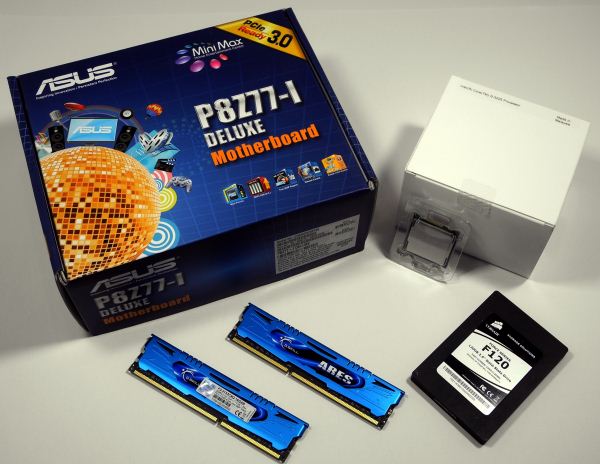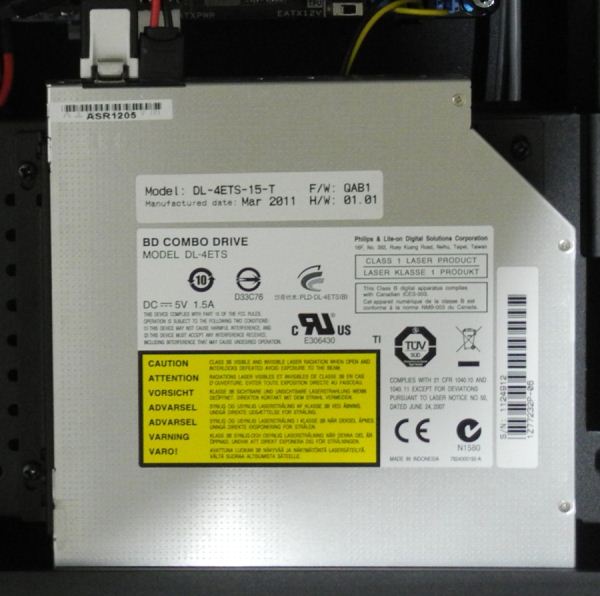Streacom's FC10 and Nano150: Building a Fanless Ivy Bridge HTPC
by Ganesh T S on December 22, 2012 3:30 AM EST- Posted in
- HTPC
- Fanless
- Ivy Bridge
HTPC Testbed Components
In choosing the Streacom FC10 and Nano150 as the chassis and PSU for our testbed, we were practically restricted to a mITX or uATX motherboard. There was a toss up between building a Trinity-based testbed and a Ivy Bridge-based testbed. In the end, the fact that Trinity emerged as being a capable madVR candidate (with software based decoding), and the fact that madVR recently introduced DXVA scaling (an upside for Intel since its offerings weren't fully madVR capable earlier, and something that we wanted to test out) persuaded us to go for an Intel-based testbed.
Processor:
Intel's best GPU offering to date is the HD 4000, and the cheapest Ivy Bridge with the HD 4000 GPU is the Core i3-3225. The Core i3-3225 is a 2C/4T processor with a 55W TDP. It has a 3 MB L3 cache, and can run at 3.3 GHz. The HD4000 runs at 650 MHz by default, but, can turbo up to 1050 MHz when necessary. Like all other Ivy Bridge processors, we have support for DDR3-1600 memory.
Motherboard & Chipset:
The Asus P8Z77-I Deluxe is a Z77-based mITX motherboard with integrated dual-band Wi-Fi / Bluetooth and plenty of HTPC oriented features with Wi-Fi GO!, including the ability to interact with the PC using a mobile device, making it act as a DLNA media hub and so on. This video from Asus captures the capabilities included in the Wi-Fi GO! feature. Ian will be presenting a detailed review of the P8Z77-I Deluxe. However, in the context of our HTPC testbed, the motherboard fulfills all our primary requirement that at least one free PCIe slot be available for installation of a discrete GPU at a later point in time.
Asus also has a Wi-Di enabled model with an Intel Wi-Fi adapter instead of the Broadcom-based one in the P8Z77-I Deluxe.
Memory:
We had used the G.Skill Ares kit in our Trinity HTPC testbed, and given the fact that it can run even at 2133 MHz, we decided to use the same model for this system build also. As a refresher, the DRAM runs with a 9-11-10-28 latency configuration. We also decided to use only one module to give the system 4 GB of DRAM. The reason to not go in for 8 GB will be made clear in the next section.
Primary & Optical Disk Drives:
We used one of the old SSDs lying around, the Corsair F120 120GB. Our intent was to use the SSD only for the OS and program files, and leave all the media on a NAS in another location. Installing a hard drive for increased capacity was ruled out because we wanted a silent HTPC.
One of the constraints posed by the FC10 chassis was the fact that we could only use a slot-loading optical drive. Despite the fact that we wanted a silent system, we did make one concession and decided to install a ODD in the system. Some of our ASRock HTPC samples are now being used as headless systems for network testing, and we decided to take out a Blu-ray drive (Philips Lite-On DL-4ETS) from one of those and use it in our HTPC testbed.


















63 Comments
View All Comments
sheh - Saturday, December 22, 2012 - link
I think most of the visitors here are US-based. Though yes, C would be better. :)Jaaap - Saturday, December 22, 2012 - link
On the Thermal Performance page, at the rop you say:... because it is quite common for improperly designed thermal solutions to *not* prevent processors from reaching their maximum permissible junction temperature.
not prevent?
sheh - Saturday, December 22, 2012 - link
AKA, let CPUs overheat and start throttling.sheh - Saturday, December 22, 2012 - link
...the woes of double negative. :)ganeshts - Saturday, December 22, 2012 - link
Yes, it conveys that bad thermal solutions allow the processor to reach Tjmax. Throttling results and there is a loss in performance.mobutu - Sunday, December 23, 2012 - link
I hope you'll do a full stress test on the CPU and GPU simultaneous because it is not enough if the 150W picoPSU holds this setup only on idle and low-stress.Also please find out from Streacom when the 180W and particularly the 250W will be available for purchase.
Interested in a i5/i7 + 7770 setup powered by that internal 250W max PSU.
Thanks for the review!
Subyman - Sunday, December 23, 2012 - link
I was interested until I saw the price. I know people will pay a premium for silence, but $430 seems somewhat excessive.agentsmithitaly - Sunday, December 23, 2012 - link
I know it has been already already debated, but measurement units are quite inconsistent in Anandtech's articles.Sometimes they report both Celsius and Fahrenheit for temperatures, as well as inches and millimeters for length measurements, in this case we see only metric units for the case weight, dimensions, celsius degrees for the ambient temperature, and only imperial units for case temperatures.
Is it possible to have International system of units on all articles? Not only for the international visitors I'm sure Anandtech has, but also because this is technology website, which I think it could be considered as science. And scientists use metrical units, including NASA ones. You remember what happened to the Mars Climate Orbiter, right?
Apart this, keep up the good work guys!
Landiepete - Monday, December 24, 2012 - link
I have a FC8 Evo case waiting for a build, and I'm going to try and build a HTPC with an AMD A10 on a mini-itx board. The A10-5700 has a 65W TDP AND 7660D graphics on board, and performane should be quite sufficient for HTPC. In a pinch I could try the 5800, but the 100W TDP might be just OTT;Incidentally, streacom does a nice infrared remote kit to go with their cases.
cerietke - Monday, December 24, 2012 - link
I don't know about the FC8, but for my FC5 the mini-ITX options available would not work due to something being in the way of the heatpipes (if you haven't you may want to check on that). Streacom told me they tried 95 W TDP processors for the FC5, but can only recommend them in areas with considerable airflow. My A10-5700 is already getting near 80 C, though so far I haven't been able to confirm or deny whether the case is to blame.